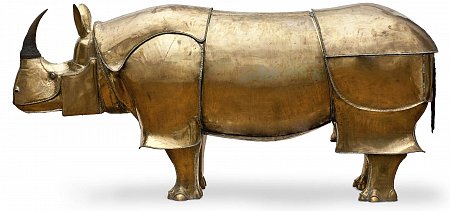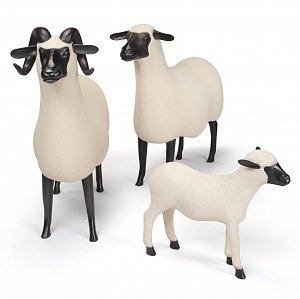Partners in life and in art, and sublime
sculptors considered a unit in the eye
of the public, Claude and François-Xavier
Lalanne were renowned for drawing
inspiration from nature and animals
in the design of their creations. Often
hybrid, their works stir emotion, surprise,
and amusement – a poetry cultivated
by Surrealism and an artistic vision guided
by plays on words, forms, and materials. With this same freedom, the Lalannes
also play with the hierarchy of the arts,
innovatively bestowing their majestic
sculptures with function and purpose.
While French public collections include
exceptional examples of their works, and
ever-more-so thanks to the dation made
to the Musée des Arts Décoratifs, the
international scope of their career has
also led to the Lalanne’s works featuring
prominently in noteworthy private
collections around the world.

François-Xavier Lalanne (1927-2008), Rhinocrétaire II, 1966
Laiton, corne de rhinocéros, bois gainé de tôle de laiton polie, cuir, acier. Achat du Rhinocrétaire II grâce au mécénat de Gregory et Regina Annenberg Weingarten / GRoW @ Annenberg, 2010. Inv. 2010.1.1
© Les Arts Décoratifs / photo : Jean Tholance © Adagp, 2022
In France, the Musée des Arts Décoratifs
displays a selection of outstanding pieces
that highlight the art and career of the
Lalannes, including the gold Bouche
(Mouth) necklace, the Ronce (Brambles)
necklace, a piece of silverware from
the Lolas set by Claude Lalanne, the
Rhinocrétaire II, a masterpiece by François-
Xavier Lalanne, made possible thanks
to the generous donation of Gregory and
Regina Annenberg Weingarten / GRoW
@ Annenberg, and a Crocodile (Crocodile)
bench by Claude Lalanne. The Claude
and François-Xavier Lalanne Dation
is structured around the sixteen works
from the dation, offering a combination
of unique objet d’art, career milestones,
and creations rendered famous by their
editions, all in keeping with the age-old
mission of the Musée des Arts Décoratifs –
“to keep alive in France the culture
of the arts which seek to make useful
things beautiful.” Displayed on podiums
in a minimalist, checkerboard formation,
the sixteen works dialogue with pieces
from the Permanent Collections of the
Musée des Arts Décoratifs, representing
a conversation between furniture and
decorative arts, the Lalanne’s two greatest
artistic interests.
Of the sixteen pieces in the exhibition,
nine are the work of François-Xavier
Lalanne and include two unique creations:
La Mouche (The Fly, 1966-1967) and
Hippopotame I (Hippopotamus I, 1966-
1969), which incorporates a sink and
a bathtub. These two pieces immediately
denote the strong characteristics
of François-Xavier Lalanne’s work, his
entry into the history of sculpture, a taste
for the monumental, and a pronounced
sense of poetry and humor.

François-Xavier Lalanne, Bélier, 2008 / Agneau, 2010 / Brebis, 2001
Founder Landowski, Edition 236/250 / Founder Blanchet, Edition 290/500 / Founder Landowski, Edition 247/250.
Bronze, epoxy resin
© Les Arts Décoratifs / Photo: Christophe Dellière © Adagp, 2022
The dation
also incorporates his projects for Têtes
Habitables (Inhabitable Heads) from
the early 1970s, including two models
stemming from collaborative projects with
architect Émile Aillaud (b. 1902 – d. 1988),
as well as preparatory drawings and iconic
sculptures such as Singe Avisé (Wise
Monkey, 2010).
Additionally, a set from the
series Nouveaux Moutons (New Sheep,
2008), evokes the logical continuation
of François-Xavier Lalanne’s research,
taking the concept of wooly sheep and
adapting them for the outdoors, a focus
of exploration late in his career, when
he developed a passion for garden art.
The seven works by Claude Lalanne
demonstrate her ambition as a sculptor.
The artistic signature, in both her thought
and execution, shows how the object
is detached from a purely decorative state,
as seen in her Ginkgo furniture (2010-
2018) composed of a table, a bench and
a pair of chairs, all of which echo the
aesthetic explorations of the 19th Century
and Art Nouveau, as well as the free
and Surrealist imagination of French
architect and designer, Emilio Terry
(b. 1890 – d. 1969).

Claude Lalanne, Moyen Choupatte, 2019
Patinated bronze
© Les Arts Décoratifs / Photo: Christophe Dellière © Adagp, 2022
Claude Lalanne drew
from Surrealism and a broad artistic culture
to create L’Homme à la Tête de Chou
(The Man with the Cabbage Head, 1968),
which inspired French singer-songwriter
Serge Gainsbourg (b. 1928 – d. 1991)
in the late 1960s, but also Choupatte
(Cabbage Feet, 2019), and Pomme (Apple,
2015). Additionally, several preparatory
drawings and sketches for key pieces such
as Âne Attelé (Harnessed Donkey) and
Canard (Duck), as well as Hippopotame
(Hippopotamus) by François-Xavier Lalanne
and studies for Claude Lalanne’s flatware
complete the collection of works.
The Claude and François-Xavier Lalanne
Dation presents a highly relevant collection
of works by François-Xavier and Claude
Lalanne while celebrating their place in
the artistic history of the 20th and early-
21st centuries. This retrospective, hosted
by one of the Lalanne’s greatest historical
supporters, the Musée des Arts Décoratifs,
is a modern-day tribute to François-
Xavier and Claude Lalanne and to their
contribution to French national patrimony.